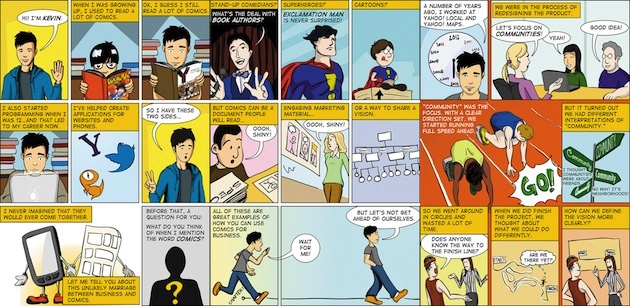Comics are one of the oldest forms of communication and have gone through many permutations, from drawings on cave walls to War and Peace-sized graphic novels. Co-creator of OK/Cancel, an online comic about interface design, Kevin Cheng is also the author of the new book, See What I Mean: How to Use Comics to Communicate Ideas (Rosenfeld).
Here, Cheng talks about the parallels between comics and UX, the joys of drawing, and the power of comics in getting your point across. You can enter to win a copy of the book below.
Comics and UX share the common struggle of having had to work extra hard at being taken seriously. Do you hear similar complaints from folks working in both fields?
I do. Obviously, UX design has become much more mainstream in the past five years and doesn’t have the same struggles it used to. The discipline is taken seriously now but perhaps still misunderstood.
Comics have long existed in more serious contexts—in film as storyboards, for instance—but I’m seeing more and more examples of comics being used in other industries, though many of these examples also feel misunderstood. The medium is often treated as a solution for reaching younger audiences or making something more light-hearted, but it doesn’t have to be constrained to that.
Do you think comics can be of particular use when UX practitioners are trying to, say, sell clients on the idea of upfront user research?
Comics can be useful as a highly concentrated form of communication to sell any idea. That said, I don’t know that they are as useful in selling the idea of research so much as the results of it. Using comics to tell the stories discovered through research can be a very powerful way to explain the findings.
I really enjoyed the two different but rewarding ways to read your book (in comic form, and as a more traditional text). Do you think that sort of flexibility has untapped merit in the digital world?
Actually, we’re seeing that everyday now because content is being designed to adapt to different devices and contexts. If you’re on a phone, you’re likely moving around and looking for immediate information (or perhaps just a bit of distraction). If you’re on an iPad, we now know that you’re likely sitting in your living room in the evening and can design browsing and discovery experiences targeted to that.
Did you have any startling realizations of your own about the persuasive power of comics as you were preparing this book?
Probably the most surprising is that, over the course of the few years I spent on the book, so many applications of comics started to surface. I’m not sure if it’s become more prevalent or it’s simply the effect of working on the book and noticing it more—much like when you buy a car and then start seeing that model everywhere on the road. I’ve seen comics on storefronts, bus stops, even in the liner of a jacket to explain how to care for it.
I also started out using comics to convey future product ideas rather than illustrating existing patterns but have found the latter application similarly powerful. Drawing out how someone solves a problem really highlights the problems encountered and puts me in their shoes.
The basic artistic instructions in the book stuck with me—I find myself sketching heads with eyes and noses in the right places to much satisfaction. Do you doodle to open up doors in your mind?
I find that sketching can be a good way to pull your mind out of details as you end up focusing on the sketch instead. However, I think the value is much higher when you’re actually drawing with intention. The sequential element of comics is as powerful as the drawing itself. If you’re actively trying to create a story, it forces you to think about how someone gets from point A to point B and what they’re trying to accomplish. General sketching and doodling does make the details (such as drawing proportions) come naturally so that you can focus on the story instead of the figure.
So you want to win this book, right? Well, all you need to do is answer a question for us:
What is your dream UX job?
There are three ways to enter the contest:
Via Twitter
- Make sure you’re following UX Magazine on Twitter.
- Create a tweet that says, “Hey @uxmag, <your answer>. Do I win a copy of See What I Mean? https://uxm.ag/13k”.
- Replace the blank with your response to the question. Make sure to keep the rest of the tweet the same.
- Publish the tweet.
Via Facebook
- Make sure you’ve ‘liked’ UX Magazine on Facebook.
- Post a message to the UX Magazine wall (not your own wall) with your response to the question.
Via Email Subscription
- Visit UX Magazine’s email subscription page.
- Fill out all of the fields.
- Click ‘Subscribe to list’.
Note: If, and only if, you’ve already subscribed via email, you can enter this giveaway by emailing your answer to [email protected].
Five winners will be chosen from the valid entries. The contest ends on Friday, February 22nd.










